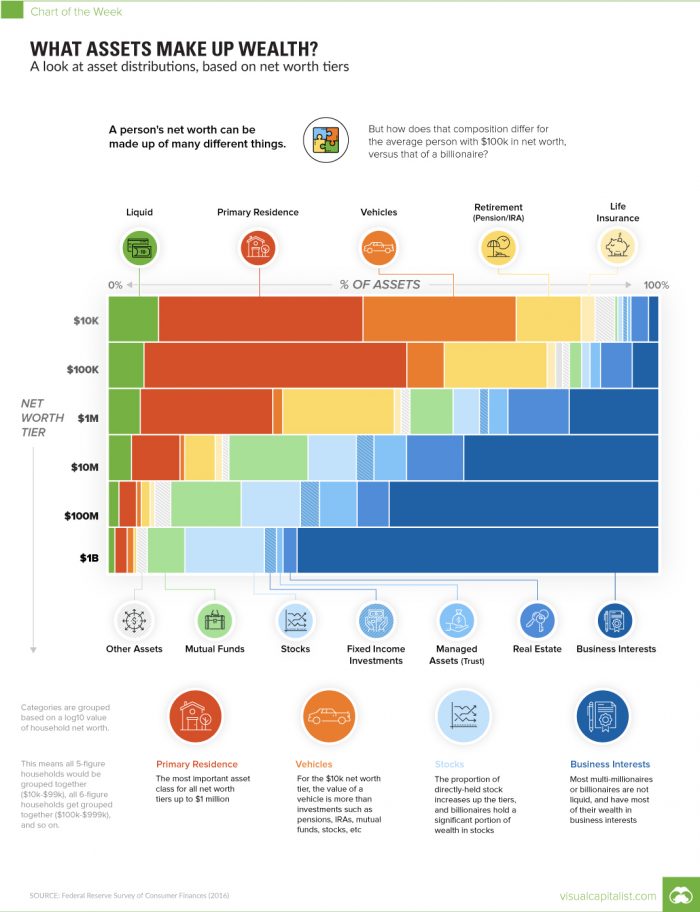- Joined
- Jul 10, 2008
- Messages
- 66,344
- Points
- 113
gobankingrates.com
Nicole Spector
17-22 minutes
It might be time to move to Indonesia.

AS Inc. / Shutterstock.com
America is the richest country in the world, and 2020 receipts prove it. During the peak of COVID, the U.S. saw the highest growth of financial assets due to tax cuts and an explosive stock market. But as all too many folks know, the prosperity is not very well spread out; in fact, the income gap is widening. Billionaires’ wealth skyrocketed during the pandemic, with data from Forbes finding that as of April 12, 2021, America’s 719 billionaires accounted for more than four times more money ($4.56 trillion) than all 165 million Americans on the bottom of the socioeconomic plane ($1.01 trillion). It wasn’t always this way. Back in 1990, it was the opposite: billionaires held $240 billion of the country’s wealth, while the bottom half of earners had $380 billion combined.
See: These Billionaires Got Richer During the Pandemic
Find: Weird Things Top Billionaires Have in Common
As the rich get richer and the poor get poorer, the U.S. is hardly the country where everyone’s dreams can come true. It is indeed getting tougher for the middle class to hold their ground, let alone manage their bills and other expenses. Could it be worse though, if you lived in another country? In other words, is the cost of living considerably less elsewhere? The answer is: Absolutely yes.
Here’s a look at how much you need to be considered rich in 23 countries around the world.
Last updated: June 22, 2021
More: 10 of the World’s Richest Millennials — And What We Can Learn From Them
Discover: The Richest Celebrity From Every State
Try: How To Invest In Foreign and International Stocks
Related: LeBron James, David Beckham and the Richest Athletes In The World
Learn: China To Sell Off Reserves of Aluminum, Copper and Zinc In Order To Tame Prices
More: The 50 Cheapest Countries To Retire To
See: 24 Ways To Stretch Your Unemployment Benefits
Here's How Much You Need To Earn To Be 'Rich' in 23 Major Countries Around the World
Nicole Spector
17-22 minutes
It might be time to move to Indonesia.

AS Inc. / Shutterstock.com
America is the richest country in the world, and 2020 receipts prove it. During the peak of COVID, the U.S. saw the highest growth of financial assets due to tax cuts and an explosive stock market. But as all too many folks know, the prosperity is not very well spread out; in fact, the income gap is widening. Billionaires’ wealth skyrocketed during the pandemic, with data from Forbes finding that as of April 12, 2021, America’s 719 billionaires accounted for more than four times more money ($4.56 trillion) than all 165 million Americans on the bottom of the socioeconomic plane ($1.01 trillion). It wasn’t always this way. Back in 1990, it was the opposite: billionaires held $240 billion of the country’s wealth, while the bottom half of earners had $380 billion combined.
See: These Billionaires Got Richer During the Pandemic
Find: Weird Things Top Billionaires Have in Common
As the rich get richer and the poor get poorer, the U.S. is hardly the country where everyone’s dreams can come true. It is indeed getting tougher for the middle class to hold their ground, let alone manage their bills and other expenses. Could it be worse though, if you lived in another country? In other words, is the cost of living considerably less elsewhere? The answer is: Absolutely yes.
Here’s a look at how much you need to be considered rich in 23 countries around the world.
Last updated: June 22, 2021
1. Australia
- Annual pre-tax income needed to be in the 1%: $219,931
- Annual pre-tax income needed to be in the top 10%: 103,376
More: 10 of the World’s Richest Millennials — And What We Can Learn From Them
2. Bangladesh
- Annual pre-tax income needed to be in the 1%: $42,746
- Annual pre-tax income needed to be in the top 10%: $12,338
Discover: The Richest Celebrity From Every State
3. Brazil
- Annual pre-tax income needed to be in the 1%: $150,658
- Annual pre-tax income needed to be in the top 10%: $34,751
Try: How To Invest In Foreign and International Stocks
4. Canada
- Annual pre-tax income needed to be in the 1%: $268,197
- Annual pre-tax income needed to be in the top 10%: $107,026
Related: LeBron James, David Beckham and the Richest Athletes In The World
5. China
- Annual pre-tax income needed to be in the 1%: $121,168
- Annual pre-tax income needed to be in the top 10%: $44,182
Learn: China To Sell Off Reserves of Aluminum, Copper and Zinc In Order To Tame Prices
6. Egypt
- Annual pre-tax income needed to be in the 1%: $152,424
- Annual pre-tax income needed to be in the top 10%: $39,906
7. Ethiopia
- Annual pre-tax income needed to be in the 1%: $35,868
- Annual pre-tax income needed to be in the top 10%: $8,381
8. France
- Annual pre-tax income needed to be in the 1%: $251,865
- Annual pre-tax income needed to be in the top 10%: $92,016
9. Germany
- Annual pre-tax income needed to be in the 1%: $327,069
- Annual pre-tax income needed to be in the top 10%: $100,996
10. India
- Annual pre-tax income needed to be in the 1%: $93,917
- Annual pre-tax income needed to be in the top 10%: $14,077
11. Indonesia
- Annual pre-tax income needed to be in the 1%: $113,939
- Annual pre-tax income needed to be in the top 10%: $30,544
More: The 50 Cheapest Countries To Retire To
12. Italy
- Annual pre-tax income needed to be in the 1%: $207,748
- Annual pre-tax income needed to be in the top 10%: $78,923
13. Japan
- Annual pre-tax income needed to be in the 1%: $240,301
- Annual pre-tax income needed to be in the top 10%: $89,643
14. Korea
- Annual pre-tax income needed to be in the 1%: $234,887
- Annual pre-tax income needed to be in the top 10%: $79,531
15. Mexico
- Annual pre-tax income needed to be in the 1%: $187,917
- Annual pre-tax income needed to be in the top 10%: $51,709
16. Nigeria
- Annual pre-tax income needed to be in the 1%: $87,331
- Annual pre-tax income needed to be in the top 10%: $23,638
17. Pakistan
- Annual pre-tax income needed to be in the 1%: $70,024
- Annual pre-tax income needed to be in the top 10%: $16,058
18. Philippines
- Annual pre-tax income needed to be in the 1%: $102,436
- Annual pre-tax income needed to be in the top 10%: $26,512
See: 24 Ways To Stretch Your Unemployment Benefits
19. Russian Federation
- Annual pre-tax income needed to be in the 1%: $174,753
- Annual pre-tax income needed to be in the top 10%: $44,195
20. Singapore
- Annual pre-tax income needed to be in the 1%: $627,111
- Annual pre-tax income needed to be in the top 10%: $193,352
21. The United Kingdom
- Annual pre-tax income needed to be in the 1%: $255,019
- Annual pre-tax income needed to be in the top 10%: $84,900
22. The United States
- Annual pre-tax income needed to be in the 1%: $506,752
- Annual pre-tax income needed to be in the top 10%: $138,475



